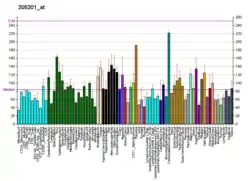GLI3
GLI3 با نامِ کامل پروتئین GLI3 انگشت روی (انگلیسی: Zinc finger protein GLI3) یک پروتئین است که در انسان توسط ژن «GLI3» کُدگذاری میشود.[4][5]
نقش و اهمیت بالینی
این پروتئین در رویانزایی،[5] شکلگیری انگشت پا،[6] و همچنین در شکلگیری غضروف و اندازهٔ سوراخهای بینی انسان نقش دارد.[7] جهش در ژن «GLI3» در موشها، سبب ناهنجاریهایی در دستگاه عصبی مرکزی، شـُش و همچنین پُـرانگشتی میشود.[8][9][10][11][12] در انسان نیز جهش در این ژن سبب بروز ناهنجاریهای مختلفی از جمله «سندرم کِـرِگ سفالوپلیسینداکتیلی» میگردد.[5]
منابع
- GRCm38: Ensembl release 89: ENSMUSG00000021318 - Ensembl, May 2017
- "Human PubMed Reference:". National Center for Biotechnology Information, U.S. National Library of Medicine.
- "Mouse PubMed Reference:". National Center for Biotechnology Information, U.S. National Library of Medicine.
- Ruppert JM, Vogelstein B, Arheden K, Kinzler KW (October 1990). "GLI3 encodes a 190-kilodalton protein with multiple regions of GLI similarity". Molecular and Cellular Biology. 10 (10): 5408–15. doi:10.1128/mcb.10.10.5408. PMC 361243. PMID 2118997.
- "Entrez Gene: GLI3 GLI-Kruppel family member GLI3 (Greig cephalopolysyndactyly syndrome)".
- te Welscher P, Fernandez-Teran M, Ros MA, Zeller R (February 2002). "Mutual genetic antagonism involving GLI3 and dHAND prepatterns the vertebrate limb bud mesenchyme prior to SHH signaling". Genes & Development. 16 (4): 421–6. doi:10.1101/gad.219202. PMC 155343. PMID 11850405.
- «Five genes that give your nose its shape». American Association for the Advancement of Science.
- Rash BG, Grove EA (October 2007). "Patterning the dorsal telencephalon: a role for sonic hedgehog?". The Journal of Neuroscience. 27 (43): 11595–603. doi:10.1523/jneurosci.3204-07.2007. PMC 6673221 Check
|pmc=value (help). PMID 17959802. - Franz T (1994). "Extra-toes (Xt) homozygous mutant mice demonstrate a role for the Gli-3 gene in the development of the forebrain". Acta Anatomica. 150 (1): 38–44. doi:10.1159/000147600. PMID 7976186.
- Grove EA, Tole S, Limon J, Yip L, Ragsdale CW (June 1998). "The hem of the embryonic cerebral cortex is defined by the expression of multiple Wnt genes and is compromised in Gli3-deficient mice". Development. 125 (12): 2315–25. PMID 9584130.
- Hui CC, Joyner AL (March 1993). "A mouse model of greig cephalopolysyndactyly syndrome: the extra-toesJ mutation contains an intragenic deletion of the Gli3 gene". Nature Genetics. 3 (3): 241–6. doi:10.1038/ng0393-241. PMID 8387379. S2CID 345712.
- Schimmang T, Lemaistre M, Vortkamp A, Rüther U (November 1992). "Expression of the zinc finger gene Gli3 is affected in the morphogenetic mouse mutant extra-toes (Xt)". Development. 116 (3): 799–804. PMID 1289066.
- مشارکتکنندگان ویکیپدیا. «GLI3». در دانشنامهٔ ویکیپدیای انگلیسی، بازبینیشده در ۱۵ فوریه ۲۰۲۱.
پیوند به بیرون
- GLI3 protein, human در سرعنوانهای موضوعی پزشکی (MeSH) در کتابخانهٔ ملی پزشکی ایالات متحدهٔ آمریکا
This article is issued from Wikipedia. The text is licensed under Creative Commons - Attribution - Sharealike. Additional terms may apply for the media files.



